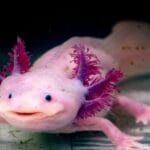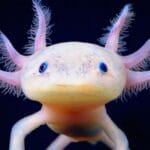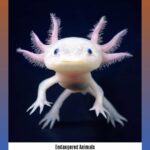Get ready to meet the axolotl, an undeniably peculiar creature that will astound you! Join us as we delve into their enchanting world and uncover fascinating facts about these captivating amphibians. From their mind-boggling ability to regenerate lost body parts to the reasons behind their endangered status, we’ll explore the secrets that make these creatures so extraordinary. Prepare yourself for a journey into the realm of the extraordinary: the world of the axolotl!
Fun Facts About Axolotls
Axolotls are unique creatures that challenge our understanding of growth and maturity. Unlike their salamander cousins who transform and move onto land, axolotls prefer to keep their youthful, aquatic charm. This phenomenon, known as neoteny, is just one of the many things that make them so fascinating.
Imagine losing a limb and then, poof, it grows back! That’s everyday life for an axolotl. These incredible amphibians have an almost magical ability to regenerate. We’re not just talking tails here; they can regenerate limbs, parts of their heart, even portions of their brain and spinal cord! Scientists are studying their regenerative prowess, hoping to unlock its secrets for potential medical breakthroughs.
Stepping into the world of axolotls is like entering a kaleidoscope. They come in a stunning array of colors and patterns. From jet black to soft pinks, pristine whites, and even shimmering golds, each axolotl boasts its own unique look. It’s like Mother Nature decided to have a bit of fun with their wardrobe! Some experts believe that their unique color patterns are largely determined by their genetic makeup, making each one a living, breathing work of art.
Ever seen an animal eat with a vacuum cleaner? Axolotls don’t have teeth in the traditional sense, so they’ve developed a cool way to snag their meals – suction feeding! They rapidly open their mouths, creating a vacuum-like force that sucks in unsuspecting prey. It’s a quick and efficient method that proves you don’t always need teeth to be a successful predator.
Some axolotls take the saying “look at my back, I’m growing algae” quite literally. They’ve struck up a fascinating, probably symbiotic, relationship with algae, allowing them to grow on their skin. The algae may provide camouflage, helping the axolotl blend into its surroundings, while enjoying a safe haven and the axolotl’s metabolic byproducts. It’s a win-win situation that highlights the interconnectedness of nature.
Sadly, these captivating creatures are facing a tough time in the wild. Habitat loss and pollution threaten their populations, making it more important than ever to protect them. Conservation efforts are underway, but there’s still a long way to go.
The world of axolotls is full of wonder, from their remarkable regeneration to their stunning array of colors. By learning more about them and supporting their conservation, we can help ensure these unique creatures continue to amaze us for generations to come. Did you know that llamas are born with spots? Discover more fun facts about llamas that will amaze you!
What are 10 facts about axolotls?
- Forever Young: Axolotls exhibit neoteny, meaning they retain their larval features throughout their lives, unlike other salamanders that metamorphose into terrestrial adults.
- Regeneration Superstars: These amphibians possess an astounding ability to regenerate lost or damaged body parts, including limbs, tails, heart muscle, and even portions of their brain and spinal cord.
- Underwater Beauties: Axolotls come in a mesmerizing array of colors and patterns, from jet black and pristine white to vibrant pinks and shimmering golds.
- Suction Feeding Masters: Lacking teeth, axolotls have evolved a unique feeding mechanism. They rapidly expand their mouths, creating a vacuum-like force to suck in prey.
- Mexican Origins: These fascinating creatures are native to the ancient lake complex of Xochimilco in Mexico City, Mexico.
- Critically Endangered: Sadly, axolotl populations in the wild are critically endangered due to habitat loss, pollution, and the introduction of invasive species.
- Smiling Faces: Axolotls appear to have permanent smiles due to the structure of their mouths, which are naturally upturned at the corners.
- Carnivorous Appetite: Despite their cute appearance, axolotls are carnivores, feeding primarily on small insects, worms, crustaceans, and small fish in the wild.
- Three-Chambered Heart: Unlike mammals with four-chambered hearts, axolotls possess a three-chambered heart, a characteristic shared with some other amphibians and reptiles.
- Scientific Marvels: Axolotls are extensively studied in research labs worldwide due to their regenerative abilities, offering potential insights into human medicine and tissue regeneration.
What is unusual about axolotls?
Several characteristics make axolotls stand out in the animal kingdom. Their ability to regenerate lost body parts is truly remarkable. Scientists believe this ability stems from their unique cells and the way they control their genes. Unlike other salamanders that undergo metamorphosis, axolotls retain their youthful features throughout their lives – a phenomenon known as neoteny – which is responsible for their unique appearance with external gills, a flowing tail fin, and a large head.
Their diverse range of colors and patterns adds to their mystique. It’s thought that this diversity is influenced by their genes. And then there’s their unusual feeding method: suction feeding. Without teeth, they’ve become masters of creating a vacuum in their mouths to capture prey.
While we’ve learned a lot about these amazing creatures, ongoing research continues to unravel the mysteries of their regenerative prowess, neoteny, and genetic diversity. The axolotl remains an enigma, full of surprises waiting to be discovered.
What are sad facts about axolotls?
Despite their extraordinary abilities, axolotls are facing an uphill battle for survival. Listed as critically endangered, they are threatened by habitat loss, pollution, and the introduction of invasive species to their natural home in Lake Xochimilco, Mexico.
While their regenerative abilities seem almost miraculous, even axolotls have limits. Repeated regeneration can lead to scar tissue buildup, which might hinder their ability to fully recover. Their sensitive skin and reliance on pristine water conditions make them particularly susceptible to environmental changes. Stress from pollution or inadequate habitats can impact their health, appetite, and overall well-being, making them more prone to diseases, including cancer.
Although captive breeding programs are working to conserve these creatures, their complex mating rituals and sensitivity to environmental changes make it challenging to maintain a diverse gene pool, which is vital for the long-term survival of the species.
The plight of the axolotl serves as a stark reminder of the impact human activities have on fragile ecosystems. By raising awareness about their plight and supporting conservation efforts, we can all play a part in ensuring the survival of these incredible amphibians.
Are Axolotls Smart?
While they might not be composing sonnets or solving quadratic equations, axolotls are surprisingly intelligent creatures. Studies suggest they are capable of problem-solving, navigating mazes, and even associating certain actions with rewards. Some axolotl owners report that their aquatic companions recognize them and may even swim towards them during feeding time, indicating a capacity for learning and memory.
While it’s difficult to compare their cognitive abilities directly to those of mammals like dogs or cats, axolotls display a level of intelligence that is remarkable for amphibians. Scientists are particularly interested in studying their brains to gain insights into how learning, memory, and environmental factors influence cognition.
Our understanding of axolotl intelligence is still evolving, but their ability to learn and adapt suggests a complexity that continues to fascinate researchers.
What is the Rarest Axolotl?
The axolotl world is full of surprises, including some incredibly rare and visually stunning variations. Here are a few of the most elusive:
Enigma Axolotl: The Triple Threat
Imagine winning the genetic lottery – that’s the Enigma Axolotl. This rarity possesses three recessive genetic traits, resulting in a mesmerizing appearance: a white body sprinkled with gold flecks and striking black eyes.
Chimera Axolotl: Two Become One
This axolotl is a testament to the wonders of nature’s fusion. When two developing axolotl embryos combine, the result is a Chimera Axolotl with an extraordinary patchwork of colors and patterns, making each one completely unique.
Mosaic Axolotl: A Living Mosaic
The Mosaic Axolotl is like a kaleidoscope come to life. This rare variation showcases a mesmerizing blend of colors and patterns that seem to shift and change depending on how you look at it. Scientists are still studying the exact mechanisms behind this stunning phenomenon.
Piebald Axolotl: The Moo-dy One
With its distinctive black and white pattern, the Piebald Axolotl resembles a miniature Holstein cow. While not as rare as the Enigma or Chimera, it’s still a unique and sought-after variation among axolotl enthusiasts.
Firefly Axolotl: The Glowing Wonder
The stuff of science fiction, the Firefly Axolotl is the result of genetic modification. By introducing a protein from a jellyfish into the axolotl’s DNA, scientists have created an axolotl that emits a soft, ethereal glow under certain light conditions.
The rarity of these axolotl variations can vary depending on breeding practices and ongoing research. The world of axolotls is always full of surprises, and new discoveries are just waiting to be uncovered.
What are axolotls weaknesses?
Despite their incredible regenerative abilities, axolotls have vulnerabilities. Their delicate, feathery gills, while beautiful, are highly sensitive to changes in water temperature, pH levels, and pollutants. Maintaining pristine water conditions is crucial for their respiratory health.
Their remarkable regeneration also has limitations. Severe injuries and repeated regeneration can take a toll on their bodies, leading to scar tissue buildup and potentially hindering their ability to fully recover. Their sensitive skin requires a smooth, stress-free environment, as rough surfaces or sharp objects can cause irritation.
Ongoing research continues to deepen our understanding of axolotl vulnerabilities and how we can best care for and protect these sensitive creatures.
Do Axolotls Have a Heart?
Yes, axolotls have hearts, but theirs are a bit different from ours. While humans have a four-chambered heart, axolotls have a three-chambered heart. This difference is a nod to their evolutionary history, reflecting their aquatic lifestyle.
Two of the chambers in an axolotl’s heart pump blood to the lungs and body, similar to the function of our hearts. However, the third chamber is dedicated to circulating blood through their gills, which are essential for underwater respiration.
While there are similarities between axolotl hearts and human hearts, such as the presence of a single ventricle, the differences highlight the axolotl’s unique adaptations for survival in its aquatic environment.
Scientists are particularly interested in studying axolotl hearts because they might hold clues to understanding human heart diseases better. Some researchers believe that studying the axolotl’s three-chambered heart could provide valuable insights into conditions like double inlet left ventricle (DILV), a rare congenital heart defect.
How fast is an axolotl?
Axolotls are not known for their speed. Research suggests they can reach speeds of up to 10 miles per hour (16 kilometers per hour), but these bursts of speed are typically short-lived, used primarily for catching prey. They are generally more content to glide gracefully through the water at a more leisurely pace.
Factors like age, tank size, and overall health can influence an axolotl’s speed. Younger axolotls tend to be more energetic and quicker than their older counterparts. The size of their habitat also plays a role, as limited space can restrict their movement and, therefore, their speed.
Why Do Axolotls Smile?
Those perpetually upturned mouths that give axolotls their characteristic “smiles” are a result of their unique anatomy, not necessarily a reflection of happiness or contentment. Unlike humans, who use facial muscles to smile, an axolotl’s mouth shape is determined by its skull bones and jaw muscle structure. Their upturned mouths are simply their natural resting face.
While their “smiles” are not expressions of emotion in the same way as ours, they do play a role in their underwater communication. Since they can’t rely on vocalizations, their upturned mouths likely help them send visual signals to each other.
Why are axolotls cute?
What is it about axolotls that makes them so irresistibly cute? Their unique combination of neotenous features, those perpetually “smiling” mouths, feathery gills, and diverse array of colors tugs at our heartstrings.
Their neoteny, or retention of juvenile features, gives them a baby-like appearance with large eyes, round bodies, and those adorable external gills. Studies suggest that this “baby schema” triggers a nurturing instinct in humans, making us find them inherently endearing.
Their seemingly permanent “smiles”, a result of their upturned mouths, add to their charm, making them appear perpetually cheerful and approachable. Their feathery, external gills, essential for breathing underwater, lend an air of whimsy and otherworldliness to their appearance.
And let’s not forget the incredible variety of colors and patterns they exhibit, from soft pinks and whites to striking blacks and shimmering golds. Their diversity is a testament to the wonders of genetics and makes each axolotl unique and captivating.
Axolotls have captivated hearts and minds worldwide with their unique blend of unusual traits, captivating beauty, and air of gentle curiosity. They are a reminder of the incredible diversity of life on Earth and the importance of protecting our planet’s most vulnerable inhabitants.
- China II Review: Delicious Food & Speedy Service - April 17, 2025
- Understand Virginia’s Flag: History & Debate - April 17, 2025
- Explore Long Island’s Map: Unique Regions & Insights - April 17, 2025

















1 thought on “Unveiling the Adorable Oddball: Fun Facts About Axolotls”
Comments are closed.